Why can downstream plants run at high capacity amid plain business?
Operating rate of downstream market remained high although new orders kept poor, peak-season performance was worse than anticipated and stocks of grey fabric continued mounting. Such contrast confused market players.
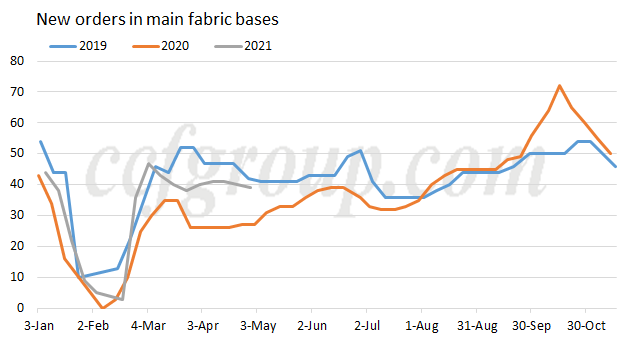
As for the tendency of new orders, orders gradually recovered in the second half of 2020. Demand surged in Q4 2020 supported by foreign orders for the Christmas Day from Europe and US, the order transfer from India, online shopping spree in China in Nov and Dec, cold winter expectation and bottom-fishing procurement from downstream buyers. Players held much anticipation toward 2021. However, demand is worse than anticipated year to date amid hiking feedstock price. Mar-Apr were traditional peak season, but the performance was worse than anticipated. Stocks of grey fabric started rising from late-Mar.
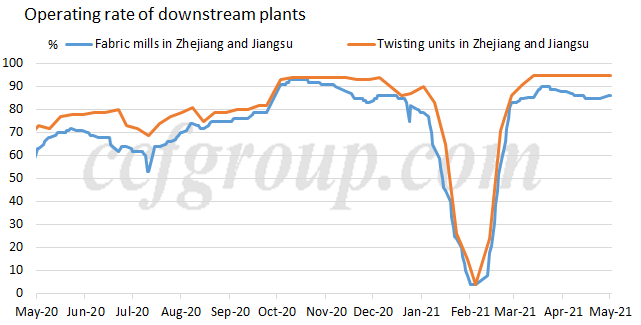
Operating rate of twisting units and fabric mills sustained high despite of plain business, which was mainly based on the following reasons:
Firstly, downstream buyers replenished feedstock under low price after end-user demand improved since the second half of 2020, and their profit gradually improved, especially in Q4 2020 and Q1 2021. Average PFY stocks of downstream plants was mainly above 20 days since last year. Based on the POY price 20 days before, profit of DTY started rising apparently since the second half of 2020, which was very high in Q4 2020 and Q1 2021. Some small DTY plants that hoarded up ample POY before the Lunar Chinese New Year holiday have completed the profit target in the first half of 2021 within Q1. Fabric mills witnessed lower profit than DTY plants, but most DTY plants saw sound profit in Q4 2020 and Q1 2021 too, especially those preparing many stocks earlier. Downstream players saw sharply falling profit after low-priced feedstock being used up after Apr. The profit has been meager based on spot POY price or POY purchased before.
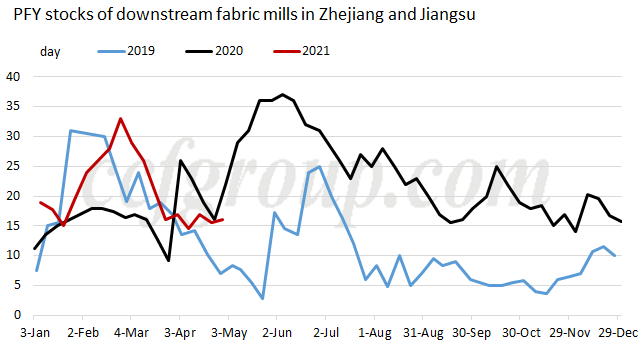
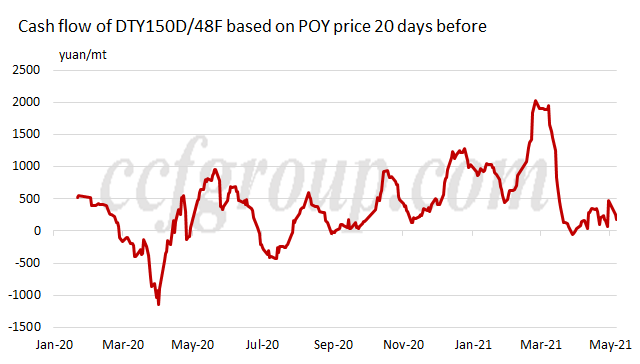
Secondly, stocks of grey fabric apparently declined in Q4 2020 and at the beginning of 2021 despite of meager business, but overall inventory burden could not be described as big even after accumulated in Mar-Apr. Downstream players still held anticipation toward demand in the second half of 2021. Current grey fabric price was not high compared with other products or compared with last year. Players thought inventory may not devalue much. It really tests downstream players’ capital and storage capability. Downstream participants are willing to accept rising stocks as long as it is within their tolerance range.
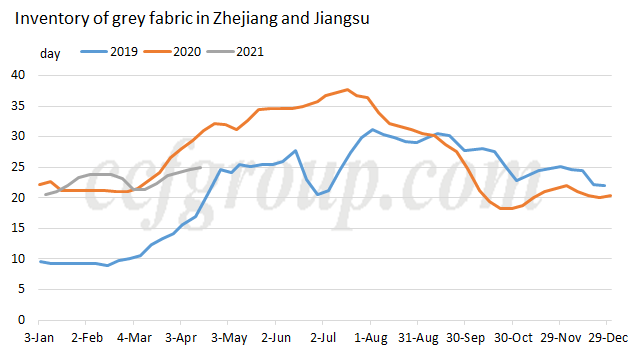
Thirdly, there is massive new capacity in downstream fabric manufacturing and DTY market. Textile workers have been short in recent years. Wage of workers has increased by 5-10% in 2021. Therefore, factories would try their best to retain workers by curbing run rate from dropping.
All in all, downstream plants have seen substantially decreasing profit, with minor profit or near cost line now. Stocks of grey fabric also apparently rose compared with early-2021. That meant bigger production and operation pressure. Downstream players may sustain high run rate in short run but downward pressure is enlarging. Buyers show obviously declining buying interest, with reducing feedstock stocks at hand. If demand fails to improve for long, factories may be forced to slash run rate.
Downstream players are expected to purchase intensively when PFY price is low but retreat to sideline amid high PFY price in May. Stocks of grey fabric have climbed up, occupying working capital, which may prohibit mills to restock.
Sales of PFY may be tolerable periodically as feedstock cost enjoys support. PFY plants are still anticipated to see high cash flow and high cash flow in May, but the cash flow may be squeezed compared with Apr.
Polyester polymerization rate is expected to reduce in May but the support to PFY market may sustain. Among polyester products, POY witnessed the smallest pressure and the highest cash flow. Coarse FDY was near cost line after price being discounted. PET fiber chip also faced inventory burden and were near cost line. Cash flow of PET bottle chip was near cost line, and that of PSF has been greatly narrowed. Thus, falling run rate of polyester market may be led by PET fiber chip market. PFY market is likely to enjoy support in short run.
- Top keywords
- Cotton Price
- Cotton Futures Price
- Cotton Futures
- CZCE
- PTA Futures Price
- Chemical Fiber
- Polyester Prices
- Wool price
- PTA Futures
- Shengze Silk
- China
- Yarn Price
- price
- China Textile City
- Fibre Price
- Benzene Price
- Cotton
- Index
- Cotton Index
- PTA
- fabric price
- NYMEX
- Top 10
- textile industry
- Spot Cotton
- Cotton Yarn
- Polyester Price
- Futures
- PTA Price
- cotton yarn price

